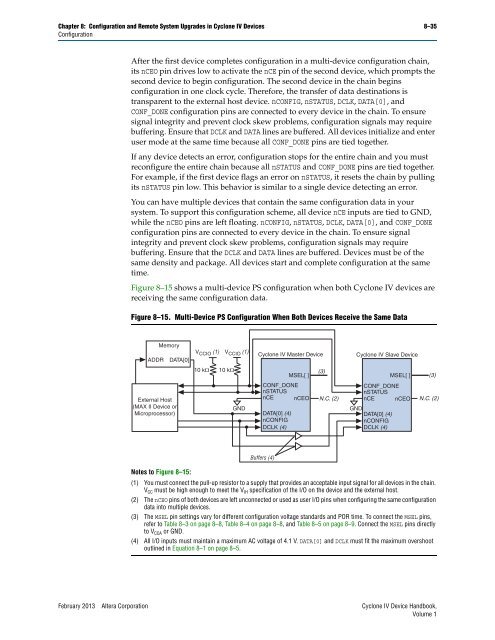Configuration and Remote System Upgrades in Cyclone IV ... - Altera
Configuration and Remote System Upgrades in Cyclone IV ... - Altera
Configuration and Remote System Upgrades in Cyclone IV ... - Altera
You also want an ePaper? Increase the reach of your titles
YUMPU automatically turns print PDFs into web optimized ePapers that Google loves.
Chapter 8: <strong>Configuration</strong> <strong>and</strong> <strong>Remote</strong> <strong>System</strong> <strong>Upgrades</strong> <strong>in</strong> <strong>Cyclone</strong> <strong>IV</strong> Devices 8–35<br />
<strong>Configuration</strong><br />
After the first device completes configuration <strong>in</strong> a multi-device configuration cha<strong>in</strong>,<br />
its nCEO p<strong>in</strong> drives low to activate the nCE p<strong>in</strong> of the second device, which prompts the<br />
second device to beg<strong>in</strong> configuration. The second device <strong>in</strong> the cha<strong>in</strong> beg<strong>in</strong>s<br />
configuration <strong>in</strong> one clock cycle. Therefore, the transfer of data dest<strong>in</strong>ations is<br />
transparent to the external host device. nCONFIG, nSTATUS, DCLK, DATA[0], <strong>and</strong><br />
CONF_DONE configuration p<strong>in</strong>s are connected to every device <strong>in</strong> the cha<strong>in</strong>. To ensure<br />
signal <strong>in</strong>tegrity <strong>and</strong> prevent clock skew problems, configuration signals may require<br />
buffer<strong>in</strong>g. Ensure that DCLK <strong>and</strong> DATA l<strong>in</strong>es are buffered. All devices <strong>in</strong>itialize <strong>and</strong> enter<br />
user mode at the same time because all CONF_DONE p<strong>in</strong>s are tied together.<br />
If any device detects an error, configuration stops for the entire cha<strong>in</strong> <strong>and</strong> you must<br />
reconfigure the entire cha<strong>in</strong> because all nSTATUS <strong>and</strong> CONF_DONE p<strong>in</strong>s are tied together.<br />
For example, if the first device flags an error on nSTATUS, it resets the cha<strong>in</strong> by pull<strong>in</strong>g<br />
its nSTATUS p<strong>in</strong> low. This behavior is similar to a s<strong>in</strong>gle device detect<strong>in</strong>g an error.<br />
You can have multiple devices that conta<strong>in</strong> the same configuration data <strong>in</strong> your<br />
system. To support this configuration scheme, all device nCE <strong>in</strong>puts are tied to GND,<br />
while the nCEO p<strong>in</strong>s are left float<strong>in</strong>g. nCONFIG, nSTATUS, DCLK, DATA[0], <strong>and</strong> CONF_DONE<br />
configuration p<strong>in</strong>s are connected to every device <strong>in</strong> the cha<strong>in</strong>. To ensure signal<br />
<strong>in</strong>tegrity <strong>and</strong> prevent clock skew problems, configuration signals may require<br />
buffer<strong>in</strong>g. Ensure that the DCLK <strong>and</strong> DATA l<strong>in</strong>es are buffered. Devices must be of the<br />
same density <strong>and</strong> package. All devices start <strong>and</strong> complete configuration at the same<br />
time.<br />
Figure 8–15 shows a multi-device PS configuration when both <strong>Cyclone</strong> <strong>IV</strong> devices are<br />
receiv<strong>in</strong>g the same configuration data.<br />
Figure 8–15. Multi-Device PS <strong>Configuration</strong> When Both Devices Receive the Same Data<br />
ADDR<br />
Memory<br />
External Host<br />
(MAX II Device or<br />
Microprocessor)<br />
DATA[0]<br />
Notes to Figure 8–15:<br />
V CCIO (1) V CCIO (1)<br />
10 k<br />
10 k<br />
GND<br />
<strong>Cyclone</strong> <strong>IV</strong> Master Device<br />
MSEL[ ]<br />
CONF_DONE<br />
nSTATUS<br />
nCE nCEO<br />
DATA[0] (4)<br />
nCONFIG<br />
DCLK (4)<br />
Buffers (4)<br />
N.C. (2)<br />
<strong>Cyclone</strong> <strong>IV</strong> Slave Device<br />
CONF_DONE<br />
nSTATUS<br />
nCE nCEO N.C. (2)<br />
GND<br />
DATA[0] (4)<br />
nCONFIG<br />
DCLK (4)<br />
(1) You must connect the pull-up resistor to a supply that provides an acceptable <strong>in</strong>put signal for all devices <strong>in</strong> the cha<strong>in</strong>.<br />
VCC must be high enough to meet the VIH specification of the I/O on the device <strong>and</strong> the external host.<br />
(2) The nCEO p<strong>in</strong>s of both devices are left unconnected or used as user I/O p<strong>in</strong>s when configur<strong>in</strong>g the same configuration<br />
data <strong>in</strong>to multiple devices.<br />
(3) The MSEL p<strong>in</strong> sett<strong>in</strong>gs vary for different configuration voltage st<strong>and</strong>ards <strong>and</strong> POR time. To connect the MSEL p<strong>in</strong>s,<br />
refer to Table 8–3 on page 8–8, Table 8–4 on page 8–8, <strong>and</strong> Table 8–5 on page 8–9. Connect the MSEL p<strong>in</strong>s directly<br />
to VCCA or GND.<br />
(4) All I/O <strong>in</strong>puts must ma<strong>in</strong>ta<strong>in</strong> a maximum AC voltage of 4.1 V. DATA[0] <strong>and</strong> DCLK must fit the maximum overshoot<br />
outl<strong>in</strong>ed <strong>in</strong> Equation 8–1 on page 8–5.<br />
February 2013 <strong>Altera</strong> Corporation <strong>Cyclone</strong> <strong>IV</strong> Device H<strong>and</strong>book,<br />
Volume 1<br />
(3)<br />
MSEL[ ]<br />
(3)
















